3D-Printed, Liquid-Filled Capsules of Concentrated and Stabilized Polyphenol Epigallocatechin Gallate, Developed in a Clinical Trial
Abstract
1. Introduction
2. Materials and Methods
2.1. Materials and Reagents
2.2. Manufacturing Protocol
2.3. Stability Testing
2.4. Analytical Conditions
2.4.1. Chromatographic Conditions
2.4.2. Mass Spectrometry Conditions
2.5. In Vitro Dissolution Test
2.6. Antioxidant Activity Assay
2.7. Bioavailability Studies
2.8. Statistical Analysis
3. Results and Discussion
3.1. Formulation Strategy
3.2. Filling Solution Characteristics
3.2.1. MS Characterization of the EGCG–Choline Chloride Interaction
3.2.2. Chemical Stability of the Filling Solution with Regards to Light Irradiation and Temperature
3.3. EGCG Capsules Characeteristics
3.3.1. Dissolution Studies
3.3.2. Formal Stability Studies of the EGCG Capsules
Antioxidant Activity
3.4. Bioavailability Compared between the Formulation and a Capsule Filled with EGCG Powder
4. Conclusions
Supplementary Materials
Author Contributions
Funding
Institutional Review Board Statement
Informed Consent Statement
Data Availability Statement
Conflicts of Interest
References
- Martinez-Naharro, A.; Hawkins, P.N.; Fontana, M. Cardiac Amyloidosis. Clin. Med. 2018, 18, s30–s35. [Google Scholar] [CrossRef] [PubMed]
- Yamamoto, H.; Yokochi, T. Transthyretin Cardiac Amyloidosis: An Update on Diagnosis and Treatment. ESC Heart Fail. 2019, 6, 1128–1139. [Google Scholar] [CrossRef] [PubMed]
- Ferreira, N.; Saraiva, M.J.; Almeida, M.R. Epigallocatechin-3-Gallate as a Potential Therapeutic Drug for TTR-Related Amyloidosis: “In Vivo” Evidence from FAP Mice Models. PLoS ONE 2012, 7, e29933. [Google Scholar] [CrossRef] [PubMed]
- aus dem Siepen, F.; Bauer, R.; Aurich, M.; Buss, S.; Steen, H.; Altland, K.; Kristen, A.; Katus, H.A. Green Tea Extract as a Treatment for Patients with Wild-Type Transthyretin Amyloidosis: An Observational Study. Drug Des. Dev. Ther. 2015, 9, 6319. [Google Scholar] [CrossRef] [PubMed]
- Kristen, A.V.; Lehrke, S.; Buss, S.; Mereles, D.; Steen, H.; Ehlermann, P.; Hardt, S.; Giannitsis, E.; Schreiner, R.; Haberkorn, U.; et al. Green Tea Halts Progression of Cardiac Transthyretin Amyloidosis: An Observational Report. Clin. Res. Cardiol. 2012, 101, 805–813. [Google Scholar] [CrossRef]
- Reygaert, W.C. The Antimicrobial Possibilities of Green Tea. Front. Microbiol. 2014, 5, 434. [Google Scholar] [CrossRef]
- Chow, H.-H.S.; Hakim, I.A.; Vining, D.R.; Crowell, J.A.; Ranger-Moore, J.; Chew, W.M.; Celaya, C.A.; Rodney, S.R.; Hara, Y.; Alberts, D.S. Effects of Dosing Condition on the Oral Bioavailability of Green Tea Catechins after Single-Dose Administration of Polyphenon E in Healthy Individuals. Clin. Cancer Res. 2005, 11, 4627–4633. [Google Scholar] [CrossRef]
- WO2007144368A3; Auriol, D.; Nalin, R.; Robe, P.; Lefevre, F. Water Soluble Phenolics Derivatives with Dermocosmetic and Therapeutic Applications; Filed 13 June 2007. and Issued 18 June 2009. Available online: https://patents.google.com/patent/WO2007144368A3/en (accessed on 10 January 2023).
- Granja, A.; Pinheiro, M.; Reis, S. Epigallocatechin Gallate Nanodelivery Systems for Cancer Therapy. Nutrients 2016, 8, 307. [Google Scholar] [CrossRef]
- Krupkova, O.; Ferguson, S.J.; Wuertz-Kozak, K. Stability of (−)-Epigallocatechin Gallate and Its Activity in Liquid Formulations and Delivery Systems. J. Nutr. Biochem. 2016, 37, 1–12. [Google Scholar] [CrossRef]
- EMA Level of Purification Extracts to Be Considered as Herbal Preparations—Scientific Guideline. Available online: https://www.ema.europa.eu/en/level-purification-extracts-be-considered-herbal-preparations-scientific-guideline (accessed on 10 January 2023).
- EMA ICH Q1A (R2) Stability Testing of New Drug Substances and Products—Scientific Guideline. Available online: https://www.ema.europa.eu/en/ich-q1a-r2-stability-testing-new-drug-substances-drug-products-scientific-guideline (accessed on 10 January 2023).
- De Lourdes Mata-Bilbao, M.; Andrés-Lacueva, C.; Roura, E.; Jáuregui, O.; Torre, C.; Lamuela-Raventós, R.M. A New LC/MS/MS Rapid and Sensitive Method for the Determination of Green Tea Catechins and Their Metabolites in Biological Samples. J. Agric. Food Chem. 2007, 55, 8857–8863. [Google Scholar] [CrossRef]
- Al-Duais, M.; Müller, L.; Böhm, V.; Jetschke, G. Antioxidant Capacity and Total Phenolics of Cyphostemma Digitatum before and after Processing: Use of Different Assays. Eur. Food Res. Technol. 2009, 228, 813–821. [Google Scholar] [CrossRef]
- Dotsikas, Y.; Loukas, Y.L. Efficient Determination and Evaluation of Model Cyclodextrin Complex Binding Constants by Electrospray Mass Spectrometry. J. Am. Soc. Mass Spectrom. 2003, 14, 1123–1129. [Google Scholar] [CrossRef] [PubMed]
- Kuhnert, N.; Clifford, M.N.; Müller, A. Oxidative Cascade Reactions Yielding Polyhydroxy-Theaflavins and Theacitrins in the Formation of Black Tea Thearubigins: Evidence by Tandem LC-MS. Food Funct. 2010, 1, 180. [Google Scholar] [CrossRef] [PubMed]
- Kuhnert, N. Unraveling the Structure of the Black Tea Thearubigins. Arch. Biochem. Biophys. 2010, 501, 37–51. [Google Scholar] [CrossRef] [PubMed]
- United States Pharmacopeia. Dietary Supplement Monographs, Powdered Decaffeinated Green Tea Extract. USP-NF. Rockville, MD: United States Pharmacopeia. 2022. Available online: https://doi.usp.org/USPNF/USPNF_M2500_06_01.html (accessed on 10 January 2023).
- Guo, Q.; Zhao, B.; Shen, S.; Hou, J.; Hu, J.; Xin, W. ESR Study on the Structure–Antioxidant Activity Relationship of Tea Catechins and Their Epimers. Biochim. Biophys. Acta (BBA)—Gen. Subj. 1999, 1427, 13–23. [Google Scholar] [CrossRef]
- Wang, R.; Zhou, W.; Jiang, X. Reaction Kinetics of Degradation and Epimerization of Epigallocatechin Gallate (EGCG) in Aqueous System over a Wide Temperature Range. J. Agric. Food Chem. 2008, 56, 2694–2701. [Google Scholar] [CrossRef]
- Suzuki, M.; Sano, M.; Yoshida, R.; Degawa, M.; Miyase, T.; Maeda-Yamamoto, M. Epimerization of Tea Catechins and O-Methylated Derivatives of (−)-Epigallocatechin-3-O-Gallate: Relationship between Epimerization and Chemical Structure. J. Agric. Food Chem. 2003, 51, 510–514. [Google Scholar] [CrossRef]
- Zhong, Y.; Ma, C.-M.; Shahidi, F. Antioxidant and Antiviral Activities of Lipophilic Epigallocatechin Gallate (EGCG) Derivatives. J. Funct. Foods 2012, 4, 87–93. [Google Scholar] [CrossRef]
- Cai, Z.-Y.; Li, X.-M.; Liang, J.-P.; Xiang, L.-P.; Wang, K.-R.; Shi, Y.-L.; Yang, R.; Shi, M.; Ye, J.-H.; Lu, J.-L.; et al. Bioavailability of Tea Catechins and Its Improvement. Molecules 2018, 23, 2346. [Google Scholar] [CrossRef]
- Hong, J.; Lambert, J.D.; Lee, S.-H.; Sinko, P.J.; Yang, C.S. Involvement of Multidrug Resistance-Associated Proteins in Regulating Cellular Levels of (−)-Epigallocatechin-3-Gallate and Its Methyl Metabolites. Biochem. Biophys. Res. Commun. 2003, 310, 222–227. [Google Scholar] [CrossRef]
- Jodoin, J.; Demeule, M.; Béliveau, R. Inhibition of the Multidrug Resistance P-Glycoprotein Activity by Green Tea Polyphenols. Biochim. Biophys. Acta (BBA)—Mol. Cell Res. 2002, 1542, 149–159. [Google Scholar] [CrossRef]
- Akazawa, T.; Uchida, Y.; Miyauchi, E.; Tachikawa, M.; Ohtsuki, S.; Terasaki, T. High Expression of UGT1A1/1A6 in Monkey Small Intestine: Comparison of Protein Expression Levels of Cytochromes P450, UDP-Glucuronosyltransferases, and Transporters in Small Intestine of Cynomolgus Monkey and Human. Mol. Pharm. 2018, 15, 127–140. [Google Scholar] [CrossRef] [PubMed]
- Savjani, K.T.; Gajjar, A.K.; Savjani, J.K. Drug Solubility: Importance and Enhancement Techniques. ISRN Pharm. 2012, 2012, 195727. [Google Scholar] [CrossRef] [PubMed]
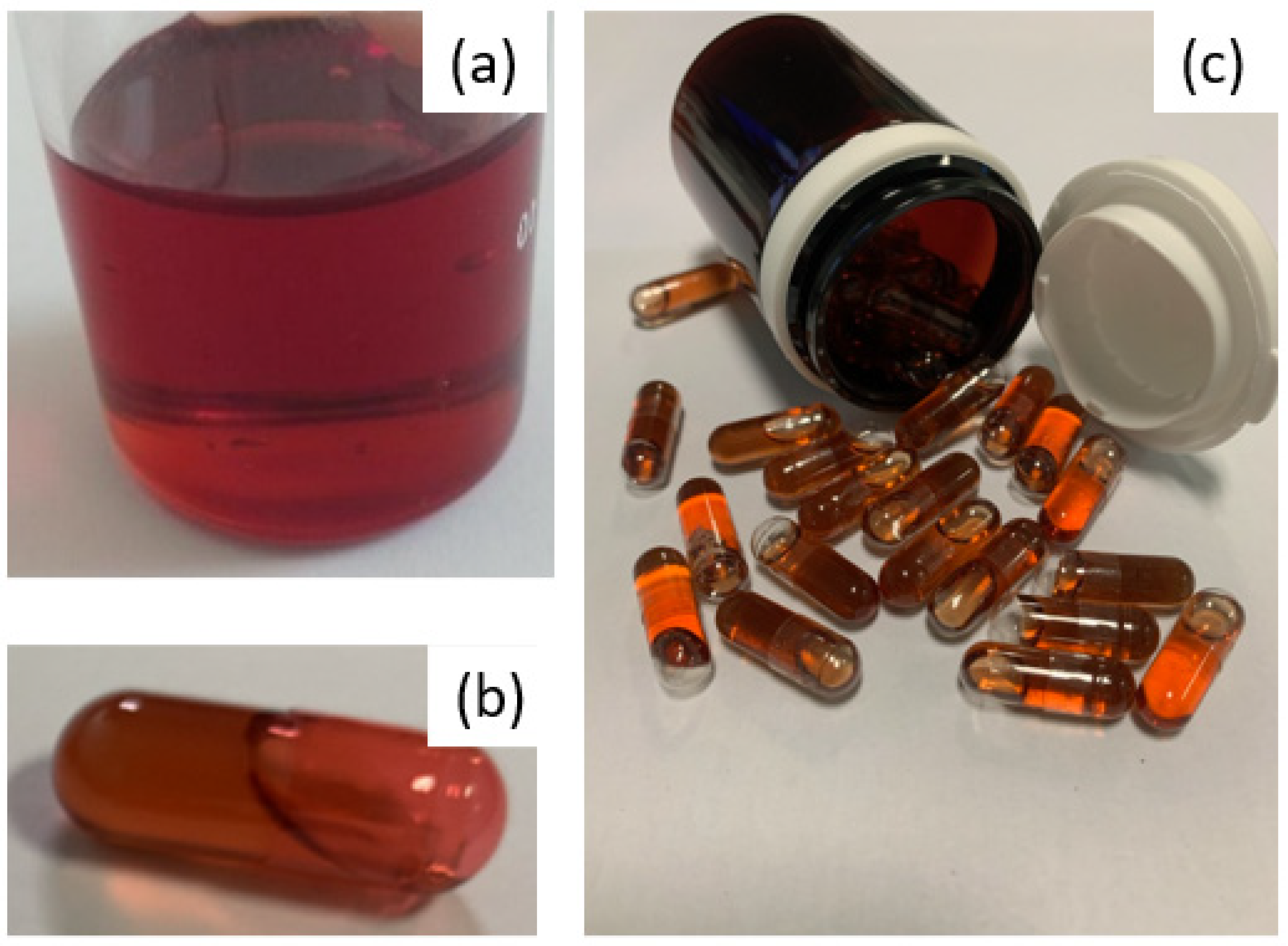
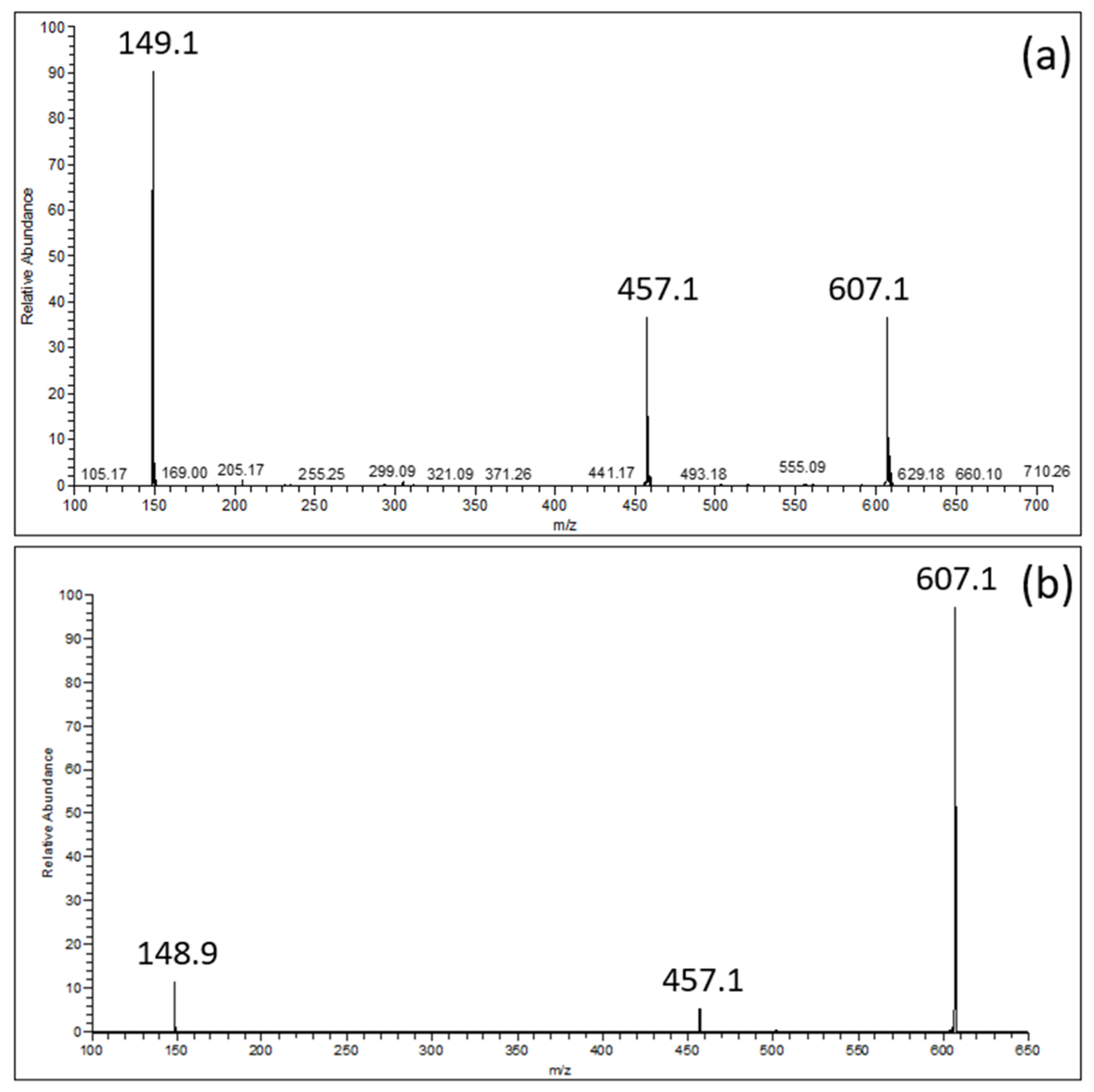
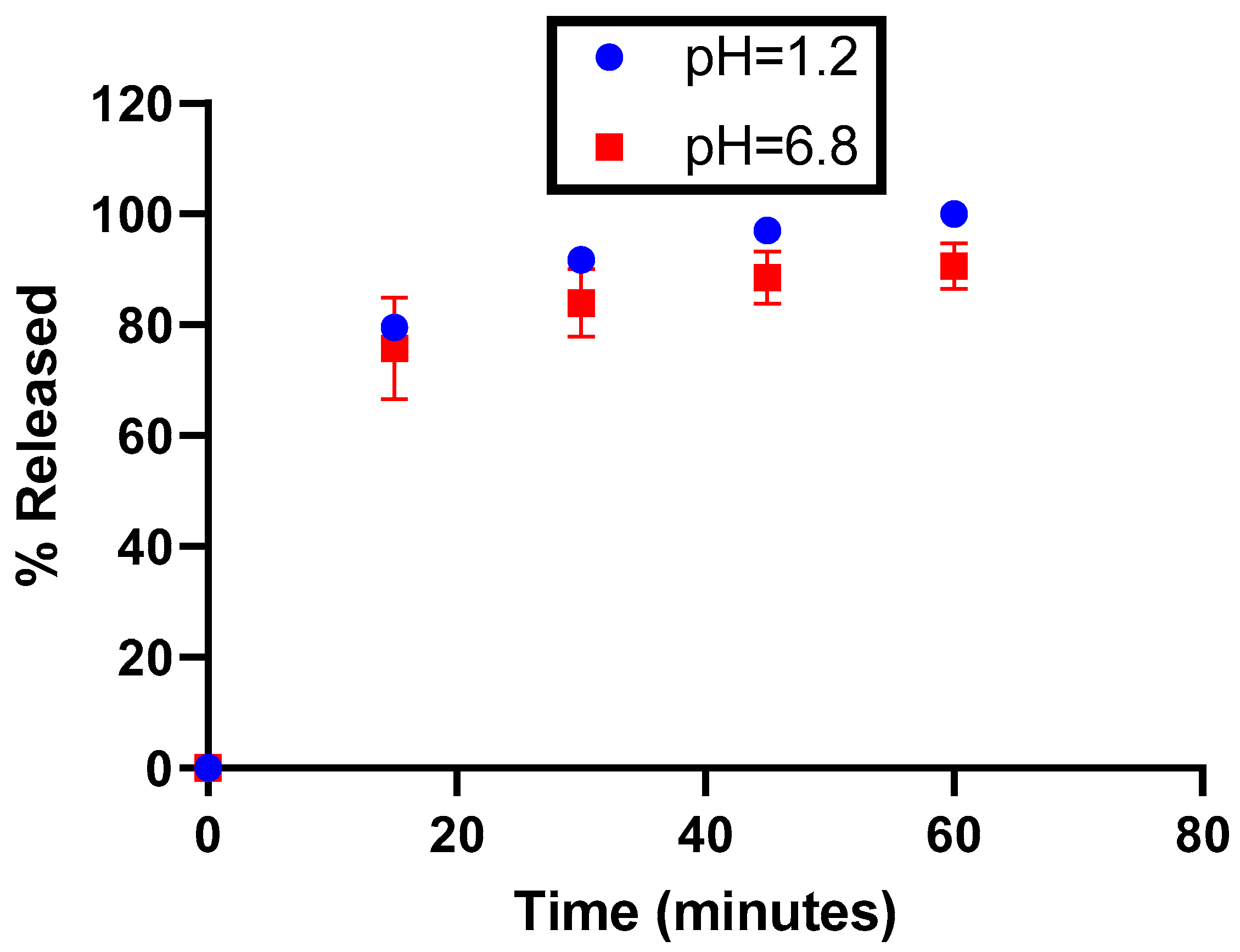
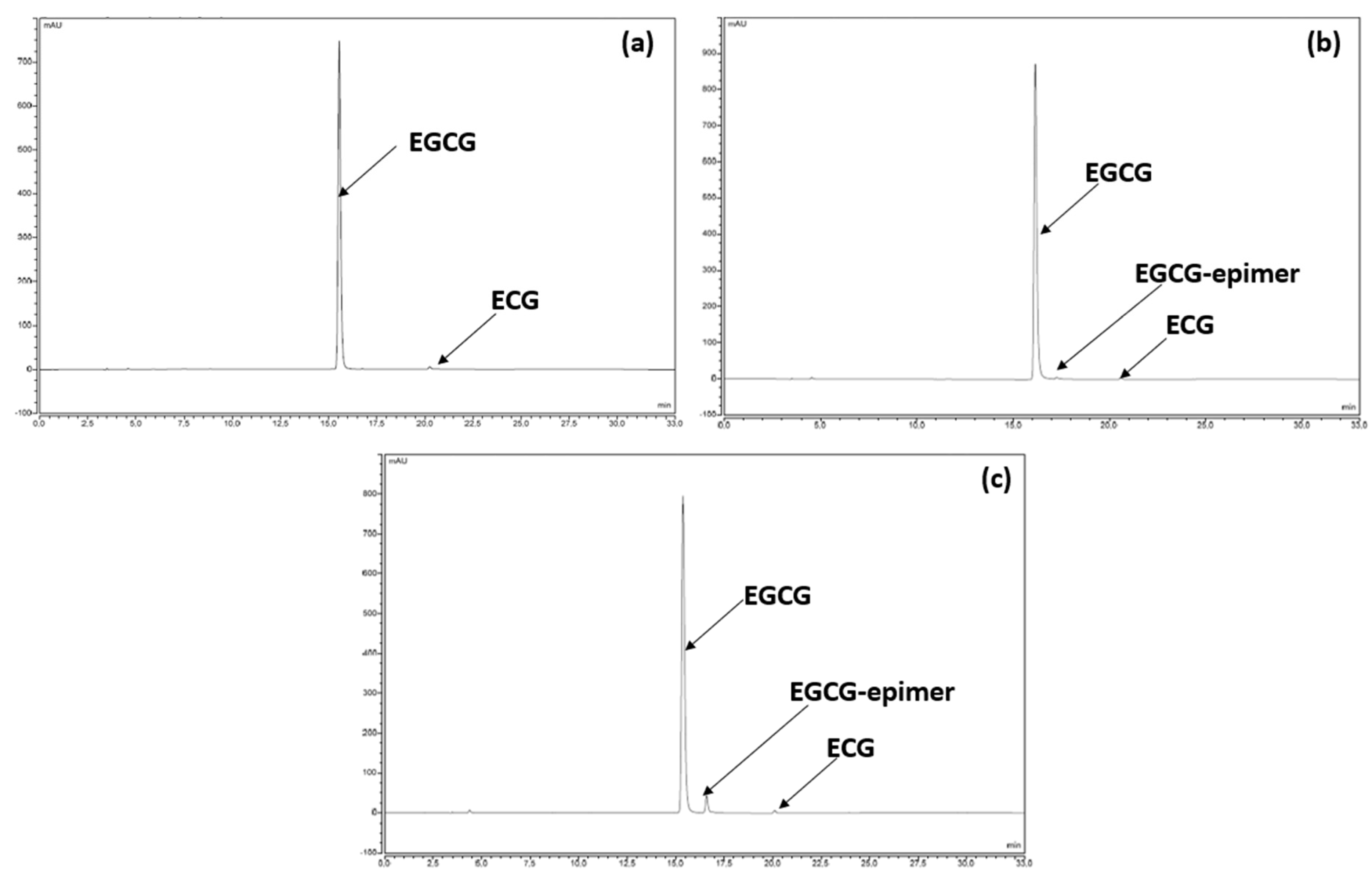
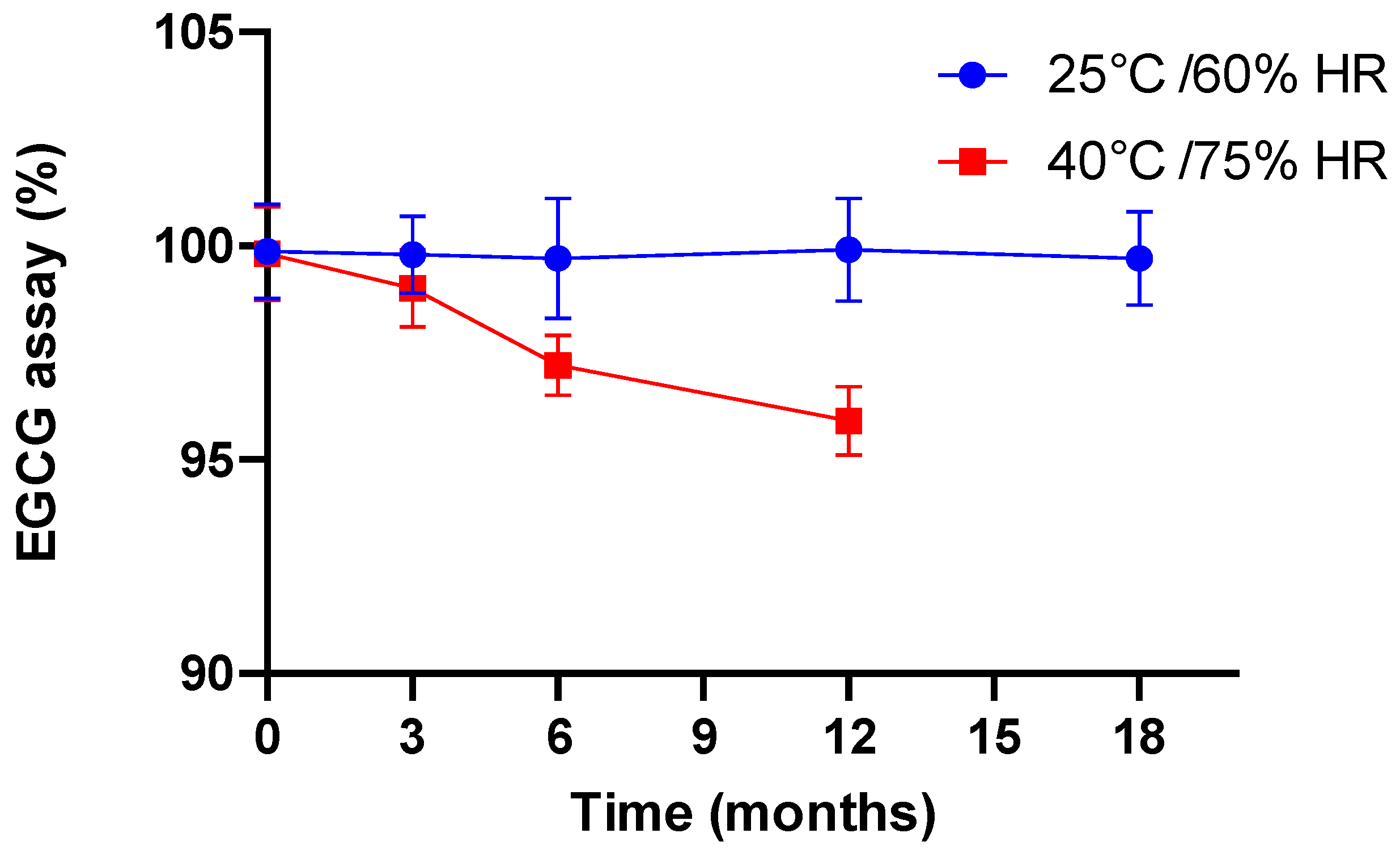
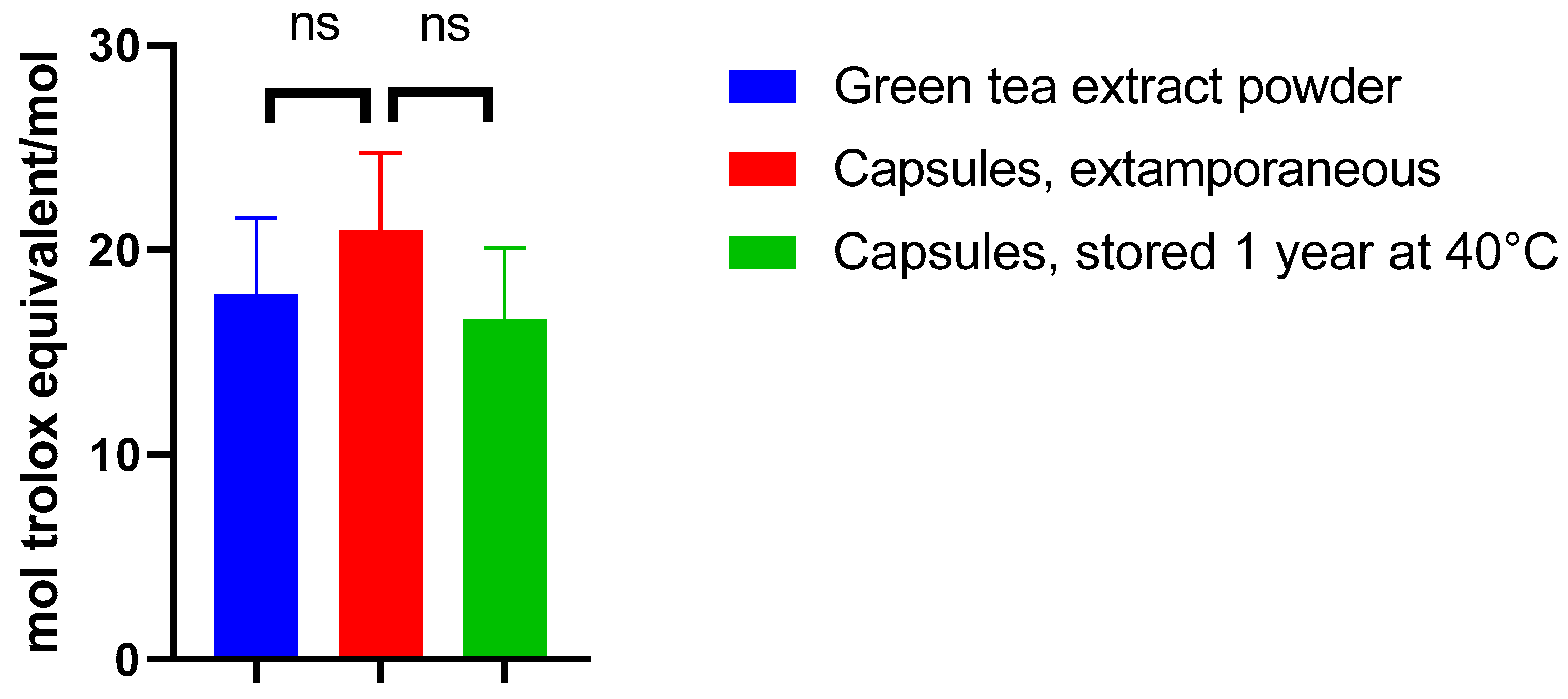

| Component | Percentage Formula | Functions |
|---|---|---|
| Green tea extract | 44.92 (i.e., 43.6% of pure EGCG, w/w) | Active ingredient |
| Polyethylene glycol 400 | 20.29 | Solvent and thickening agent |
| Polyethylene glycol 4000 | 0.67 | Thickening agent |
| Choline chloride | 16.16 | Solubilizing agent |
| Purified water | 17.96 | Solvent |
| Period | Formulation | Target Dose | Quantity of Green Tea Extract (Containing 97% of EGCG) to Administer per Animal | Blood Sampling Times for Analysis |
|---|---|---|---|---|
| 1 | Green tea extract capsule | 27 mg·kg−1 | Monkey 1: one capsule at 145.8 mg of green tea extract | 30 min, 1 h, 1.5 h, 2 h, 2.5 h, 3 h, 3.5 h, 4 h, 5 h, 7 h, 12 h, 24 h |
| Monkey 2: one capsule at 116.1 mg of green tea extract | ||||
| Monkey 3: one capsule at 108.0 mg of green tea extract | ||||
| 2 | Wash-out period (7 days) | |||
| 3 | Green tea extract eutectic solution (44.92% w/w) | 27 mg·kg−1 | Monkey 1: 323 mg of eutectic solution (145 mg of green tea extract) | 30 min, 1 h, 1.5 h, 2 h, 2.5 h, 3 h, 3.5 h, 4 h, 5 h, 7 h, 12 h, 24 h |
| Monkey 2: 258 mg of eutectic solution (116 mg of green tea extract) | ||||
| Monkey 3: 240 mg of eutectic solution (108 mg of green tea extract) | ||||
Disclaimer/Publisher’s Note: The statements, opinions and data contained in all publications are solely those of the individual author(s) and contributor(s) and not of MDPI and/or the editor(s). MDPI and/or the editor(s) disclaim responsibility for any injury to people or property resulting from any ideas, methods, instructions or products referred to in the content. |
© 2023 by the authors. Licensee MDPI, Basel, Switzerland. This article is an open access article distributed under the terms and conditions of the Creative Commons Attribution (CC BY) license (https://creativecommons.org/licenses/by/4.0/).
Share and Cite
Secretan, P.-H.; Vieillard, V.; Thirion, O.; Annereau, M.; Yayé, H.S.; Astier, A.; Paul, M.; Damy, T.; Do, B. 3D-Printed, Liquid-Filled Capsules of Concentrated and Stabilized Polyphenol Epigallocatechin Gallate, Developed in a Clinical Trial. Antioxidants 2023, 12, 424. https://doi.org/10.3390/antiox12020424
Secretan P-H, Vieillard V, Thirion O, Annereau M, Yayé HS, Astier A, Paul M, Damy T, Do B. 3D-Printed, Liquid-Filled Capsules of Concentrated and Stabilized Polyphenol Epigallocatechin Gallate, Developed in a Clinical Trial. Antioxidants. 2023; 12(2):424. https://doi.org/10.3390/antiox12020424
Chicago/Turabian StyleSecretan, Philippe-Henri, Victoire Vieillard, Olivier Thirion, Maxime Annereau, Hassane Sadou Yayé, Alain Astier, Muriel Paul, Thibaud Damy, and Bernard Do. 2023. "3D-Printed, Liquid-Filled Capsules of Concentrated and Stabilized Polyphenol Epigallocatechin Gallate, Developed in a Clinical Trial" Antioxidants 12, no. 2: 424. https://doi.org/10.3390/antiox12020424
APA StyleSecretan, P.-H., Vieillard, V., Thirion, O., Annereau, M., Yayé, H. S., Astier, A., Paul, M., Damy, T., & Do, B. (2023). 3D-Printed, Liquid-Filled Capsules of Concentrated and Stabilized Polyphenol Epigallocatechin Gallate, Developed in a Clinical Trial. Antioxidants, 12(2), 424. https://doi.org/10.3390/antiox12020424






